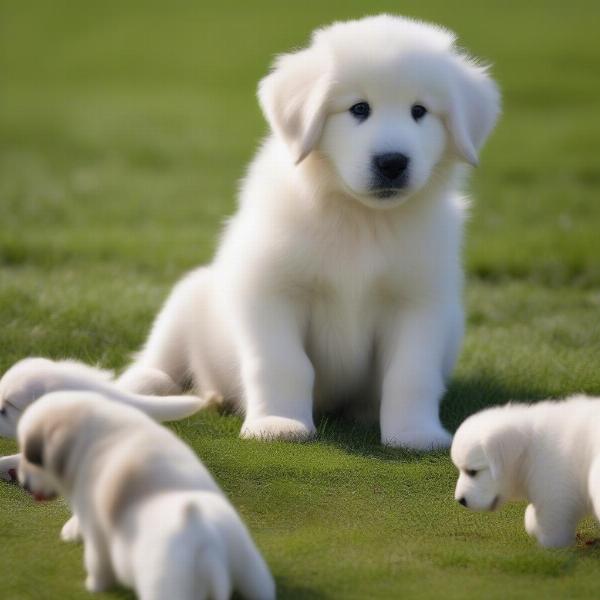The question “will Great Pyrenees kill other dogs?” is a serious one that potential owners must consider. While Great Pyrenees are generally known for their gentle nature with their families, their protective instincts, bred over centuries for guarding livestock, can sometimes lead to aggressive behavior towards other animals, including dogs. Understanding these instincts, along with proper socialization and training, is key to preventing potential conflicts and ensuring a harmonious multi-dog household or interactions with other dogs.
Decoding the Great Pyrenees’ Protective Nature
Great Pyrenees were bred to be independent guardians, making their own decisions about protecting their flock from predators. This independent, protective drive can sometimes translate to aggression towards unfamiliar dogs, especially if they perceive them as a threat to their “flock,” which could be their human family or other pets in the household. It’s not about inherent viciousness, but rather a deeply ingrained instinct to guard and protect. They may exhibit territorial behavior, barking, lunging, or even biting to ward off perceived threats.
Socialization: The Key to Harmony
Early socialization is crucial for Great Pyrenees puppies. Exposing them to a variety of dogs, sizes, and breeds from a young age helps them learn appropriate canine social skills and reduces the likelihood of aggression later in life. This includes supervised playdates with other dogs, attending puppy classes, and exposure to different environments and situations. Consistent, positive reinforcement training further reinforces desired behaviors and helps establish clear boundaries.  Great Pyrenees Puppy Socializing
Great Pyrenees Puppy Socializing
Managing a Multi-Dog Household with a Great Pyrenees
Introducing a Great Pyrenees to an existing dog requires careful management. Start with slow, controlled introductions in a neutral territory, gradually increasing the time they spend together. Supervise their interactions closely, and be prepared to separate them if any tension arises. Providing each dog with their own space and resources, such as food bowls and bedding, can help prevent resource guarding and reduce conflict.
Training and Boundaries: Establishing a Safe Environment
Training is an ongoing process with a Great Pyrenees, particularly when it comes to managing their protective instincts. Obedience training, focusing on commands like “leave it,” “come,” and “stay,” provides you with tools to control their behavior in situations where they might encounter other dogs. Establishing clear boundaries and consistent routines helps create a predictable and secure environment for both the dog and its human family.
Recognizing Warning Signs and Seeking Professional Help
It’s important to recognize the warning signs of potential aggression, such as stiff body posture, raised hackles, growling, or staring. If you notice these signs, immediately remove your Great Pyrenees from the situation. If aggression becomes a recurring problem, seek professional help from a certified dog trainer or veterinary behaviorist. They can assess the dog’s behavior and develop a tailored training plan to address the specific issues.
Conclusion
While the possibility of a Great Pyrenees displaying aggression towards other dogs exists, it’s not an inevitability. With proper socialization, consistent training, and diligent management, Great Pyrenees can coexist peacefully with other dogs. Understanding their protective instincts and taking proactive steps to mitigate potential issues is crucial for ensuring a safe and harmonious environment for everyone. Remember, responsible ownership and proactive management are key to unlocking the gentle giant within this magnificent breed.
FAQ
- Are Great Pyrenees naturally aggressive towards other dogs? Not necessarily. Their protective instincts can sometimes lead to aggression, but with proper socialization and training, they can coexist peacefully.
- How can I prevent my Great Pyrenees from being aggressive towards other dogs? Early socialization, consistent training, and establishing clear boundaries are essential for preventing aggression.
- What are the signs of aggression in a Great Pyrenees? Stiff body posture, raised hackles, growling, staring, and lunging are common warning signs.
- What should I do if my Great Pyrenees shows aggression towards another dog? Immediately remove your dog from the situation and seek professional help from a certified dog trainer or veterinary behaviorist if the behavior persists.
- Can a Great Pyrenees live in a multi-dog household? Yes, with careful introductions, management, and ongoing training.
- Is it safe to have a Great Pyrenees around small dogs? It’s possible, but extra caution and supervision are crucial due to the size difference and the Great Pyrenees’ protective instincts.
- How can I find a qualified trainer for my Great Pyrenees? Consult with your veterinarian or search for certified dog trainers or veterinary behaviorists in your area.
ILM Dog is a leading online resource dedicated to providing expert advice and valuable insights into all aspects of dog care and wellbeing. From breed selection to health, training, nutrition, and grooming, we offer a wealth of information for dog owners worldwide. We specialize in helping owners understand their dog’s unique needs, offering tailored guidance to promote happy and healthy canine companions. For more information on dog breeds, training tips, and expert advice, visit us at ILM Dog. Contact us at [email protected] or +44 20-3965-8624 for personalized support.